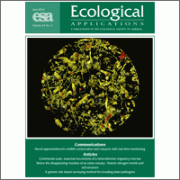Bycatch, bait, anglers, and roads: quantifying vector activity and propagule introduction risk across lake ecosystems
AUTHOR(S): D. Andrew R. Drake, Nicholas E. Mandrak
CITATION:
Drake D.A.R. and N.E, Mandrak. 2014. Bycatch, bait, anglers, and roads: quantifying vector activity and propagule introduction risk across lake ecosystems. Ecological Applications 24(4):877–894. https://doi.org/10.1890/13-0541.1
ABSTRACT:
Long implicated in the invasion process, live-bait anglers are highly mobile species vectors with frequent overland transport of fishes. To test hypotheses about the role of anglers in propagule transport, we developed a social-ecological model quantifying the opportunity for species transport beyond the invaded range resulting from bycatch during commercial bait operations, incidental transport, and release to lake ecosystems by anglers. We combined a gravity model with a stochastic, agent-based simulation, representing a 1-yr iteration of live-bait angling and the dynamics of propagule transport at fine spatiotemporal scales (i.e., probability of introducing n propagules per lake per year). A baseline scenario involving round goby (Neogobius melanostomus) indicated that most angling trips were benign; irrespective of lake visitation, anglers failed to purchase and transport propagules (benign trips, median probability P = 0.99912). However, given the large number of probability trials (4.2 million live-bait angling events per year), even the rarest sequence of events (uptake, movement, and deposition of propagules) is anticipated to occur. Risky trips (modal P = 0.00088 trips per year; ≈1 in 1136) were sufficient to introduce a substantial number of propagules (modal values, Poisson model = 3715 propagules among 1288 lakes per year; zero-inflated negative binomial model = 6722 propagules among 1292 lakes per year).
Two patterns of lake-specific introduction risk emerged. Large lakes supporting substantial angling activity experienced propagule pressure likely to surpass demographic barriers to establishment (top 2.5% of lakes with modal outcomes of five to 76 propagules per year; 303 high-risk lakes with three or more propagules per year). Small or remote lakes were less likely to receive propagules; however, most risk distributions were leptokurtic with a long right tail, indicating the rare occurrence of high propagule loads to most waterbodies. Infestation simulations indicated that the number of high-risk waterbodies could be as great as 1318 (zero-inflated negative binomial), whereas a 90% reduction in bycatch from baseline would reduce the modal number of high risk lakes to zero. Results indicate that the combination of invasive bycatch and live-bait anglers warrants management concern as a species vector, but that risk is confined to a subset of individuals and recipient sites that may be effectively managed with targeted strategies.
FULL TEXT – Drake and Mandrak



